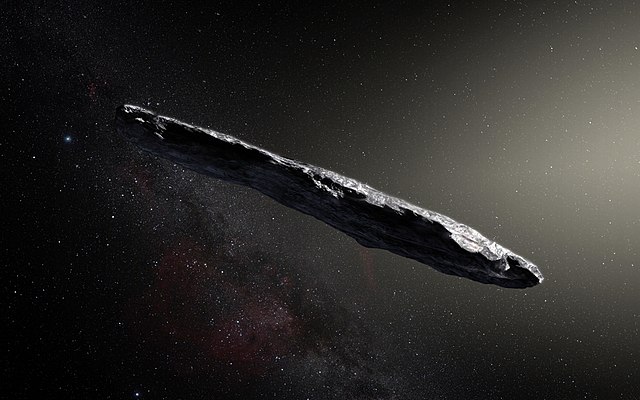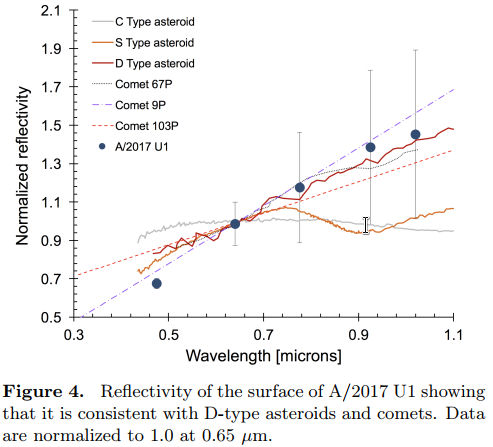The first open interstellar object turned out to be unusual.
In continuation to the previous article: Date with ʻOumuamua. The interstellar object in the Solar System is open for the first time . According to the new data, the object has the form of a highly elongated ellipsoid with a length to thickness ratio of 10: 1. The refined rotation period is 7.34 hours. The elongation can be much greater than 10, if at the minimum of brightness the object turns to us not exactly with its butt. Between the two estimated ends of the object there is a slight difference in brightness of 20%. Such an eloquent illustration appeared on the ESA official website :

New data is presented in an article in the journal Nature . It combines the observations of the object from October 25 to October 27, 2017 in different parts of the spectrum and with different instruments. The brightness curve of the U1 object now looks like this:

The spectrum of the object was also clarified:

As can be seen, in combination with previous measurements of the spectrum, the spectrum of U1 differs little from the typical spectrum of the surface of the cometary nucleus. Except for the fact that U1 is not a comet, and in terms of brightness variation it’s not at all like anything from the small bodies of the Solar System.
The variability of brightness could also be explained by the presence of spots on the surface of the object, but the absence of spectral variation with time suggests that the albedo of different parts of the surface of U1 differs little. At the same time, this is already the second article, which refers to the absence of color / spectral variability. For the first time this was mentioned in another article .
The authors also estimate the frequency of occurrence of such objects — at least one object with a size of up to 250 m in diameter should be at each moment of time within a radius of 1 AE from the Sun. That is, somewhere very close there should be the same objects. However, it is very difficult to find them. U1 was opened by lucky coincidence. The authors write that, initially, U1 was discovered as a regular asteroid with a rough estimate of the eccentricity of the orbit, approximately equal to 0.5. After some time, the object was again discovered, but with a large error in the position (due to incorrect estimation of the orbit). That is, was almost lost. Then the object was reclassified to cometlike with an eccentricity of 0.997. And again after that was almost lost. And only after the 3rd observation, suspicions of his hyperbolic trajectory began to appear. Thus, most likely, similar objects have already been observed in the set, but were later written off as “it seemed.” The authors write that if we slightly adapt the algorithms and search procedures, then discoveries of interstellar objects can fall as if from a cornucopia.
In the future, the article may appear news.

New data is presented in an article in the journal Nature . It combines the observations of the object from October 25 to October 27, 2017 in different parts of the spectrum and with different instruments. The brightness curve of the U1 object now looks like this:

The spectrum of the object was also clarified:

As can be seen, in combination with previous measurements of the spectrum, the spectrum of U1 differs little from the typical spectrum of the surface of the cometary nucleus. Except for the fact that U1 is not a comet, and in terms of brightness variation it’s not at all like anything from the small bodies of the Solar System.
The variability of brightness could also be explained by the presence of spots on the surface of the object, but the absence of spectral variation with time suggests that the albedo of different parts of the surface of U1 differs little. At the same time, this is already the second article, which refers to the absence of color / spectral variability. For the first time this was mentioned in another article .
The authors also estimate the frequency of occurrence of such objects — at least one object with a size of up to 250 m in diameter should be at each moment of time within a radius of 1 AE from the Sun. That is, somewhere very close there should be the same objects. However, it is very difficult to find them. U1 was opened by lucky coincidence. The authors write that, initially, U1 was discovered as a regular asteroid with a rough estimate of the eccentricity of the orbit, approximately equal to 0.5. After some time, the object was again discovered, but with a large error in the position (due to incorrect estimation of the orbit). That is, was almost lost. Then the object was reclassified to cometlike with an eccentricity of 0.997. And again after that was almost lost. And only after the 3rd observation, suspicions of his hyperbolic trajectory began to appear. Thus, most likely, similar objects have already been observed in the set, but were later written off as “it seemed.” The authors write that if we slightly adapt the algorithms and search procedures, then discoveries of interstellar objects can fall as if from a cornucopia.
In the future, the article may appear news.
All Articles